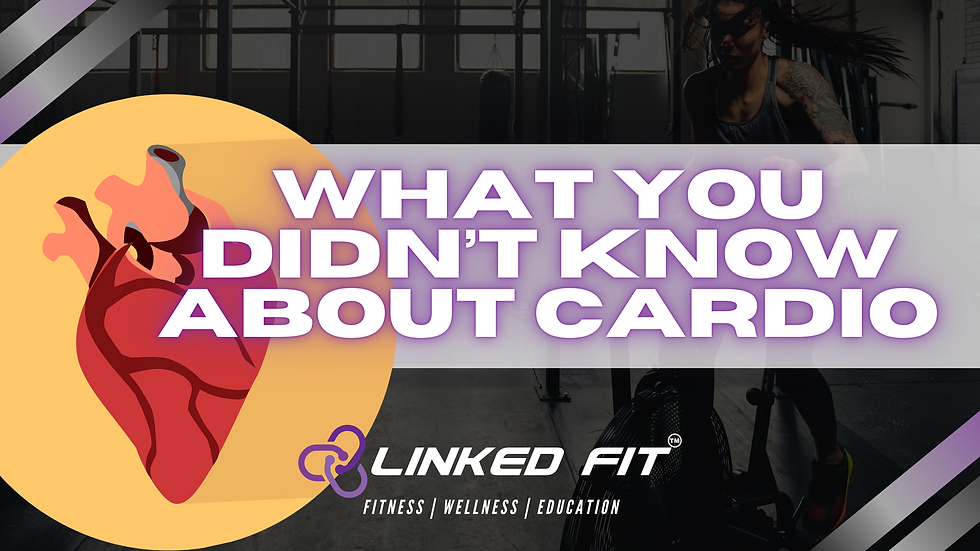Fitness is the SOLUTION
- Linked Fit

- Dec 11, 2020
- 6 min read
Updated: Apr 24, 2021

I repeat fitness is the solution!
I repeat fitness is the solution!
Introduction
For many years, a fitness and wellness plan has been utilized to promote a healthy lifestyle. Specifically, fitness has helped many individuals fight off the ramifications of muscle weakness, abnormal walking, dysfunctional balance, fatigue, cognition issues, and depression (Halabchi, Alizadeh, Sahraian, & Abolhasani, 2017). Additionally, our fight against obesity, diseases, and cancers remains at the top of the list!

Obesity is continuing to rise. In the past three decades, it has increased by 27.5% for adults and 47.1% for children (Apovian, 2016). An estimated 2.1 billion individuals in the world are overweight or obese, which is 28% of the world population (2016 statistics) (Apovian, 2016). The higher amounts of fat deposited on the body seem to provide a branching effect on other problems around the body. It doesn’t seem like it’s taking a turn for the best.
When it comes to diseases, diseases can attack a variety of systems in the body. These systems can originate from metabolic, cardiovascular, neurogenerative, autoimmune diseases, and many more (Grazioli et al., 2017). Modern medicine has helped shape the broad range of treatments, but not all formats are a perfect match for life walks. So, the population is still stuck in the process of dealing with the adverse outcomes that can progressively get worrisome, thus resulting in more considerable complications or the least favored of them all, death.
It has been noted by some scholars that cancer is known to be the leading cause of death WORLDWIDE in all countries (Torre, Siegel, Ward, & Jemal, 2016). It’s sad to say that experts expect the number of cancer cases and deaths to rapidly increases as the population continues to drastically grow with relations to age and lifestyle behaviors (Torre et al., 2016). In 2012, cancers resulted in 14.1 million new cases and 8.1 million deaths worldwide (Torre et al., 2016). These numbers are astonishing and frightening!
The science about obesity, diseases, and cancers is still incomplete, resulting in further research to help guide appropriate actions. However, at Linked Fit, we strongly advise using proper fitness programming and wellness planning to promote a world of festive production. Our world should be focused on supporting areas in life that can help reduce three large factors of negativity such as obesity, diseases, and cancers. This article will be focused on topics that fitness and wellness have SUPPORTED to improve.
Fitness & the Human Body
An appropriate fitness programming can significantly improve various physical attributes such as cardiorespiratory fitness, muscular strength, flexibility, mobility, balance, power, endurance, cognition, quality of life, and many more (Halabchi et al., 2017)! These attributes allow an optimal functioning body and can produce superior edges towards the satisfactions of life. When one puts the focus towards their body, rather than the things surrounding their life, it may likely result in greater longevity.

Despite the knowledge that may exist with some individuals about the benefits of a fitness and wellness plan, the world stills lack the application towards the recommendations. Some scholars believe that only 30% of the world’s population fails to participate in actions that trigger health benefits (Grazioli et al., 2017); however, I believe this number is way higher than 30%.
Fitness with Diseases & Cancers
An abundance of evidence is surfacing on how fitness can help modulate the mechanisms associated with various human diseases (Grazioli et al., 2017). The promotions of fitness towards the benefits of the conditions and cancers below are just a few. A variety of other diseases and cancers exist that have seen the benefits from the exertion of fitness.
Halabchi et al. (2017) has provided support that forms of fitness are considered to be a SAFE and EFFECTIVE means of rehabilitation for multiple sclerosis patients, which can improve the patient’s wellness, functional capacities, and quality of life.
When it comes to anti-inflammatory research, fitness has been supported to reduce inflammation triggers that may result in diseases linked to low-grade chronic inflammation (Bopp, Radsak, Schmitt, & Schild, 2010; Franks & Slansky, 2012).
When an individual carry’s over the application of fitness long-term, it may help reduce the risk and mortality of cancers such as breast, colorectal, and gastric cancer (Coyle et al., 2007; Hughes et al., 2011; Yuasa et al., 2009; Zeng et al., 2012; Zhang et al., 2011).
Fitness & COVID
In 2020, our world was hit with the widely known coronavirus (COVID-19), which has resulted in rough symptoms and taken the lives of many individuals (Jiménez-Pavón, Carbonell-Baeza, & Lavie, 2020). During this time, many mandated shutdowns and restrictions existed, which was entitled to be the “best” approach to stopping the spread of further infections. However, when such strict and mandates exist, radical changes in the populations' lifestyle occur (Jiménez-Pavón et al., 2020). These radical changes may result in inadequate health statuses due to the counteract of negative consequences of certain diseases such as diabetes, hypertension, cardiovascular diseases, respiratory diseases, or other associated diseases (Jiménez-Pavón et al., 2020).

Furthermore, psychological implications have been negatively associated with the COVID shutdowns, which include post-traumatic stress symptoms, confusion, and anger due to the potential factors of longer quarantine durations, fear, boredom, inadequate finances, inaccurate information, or supplies for life that have become unavailable (Jiménez-Pavón et al., 2020). Psychological stressors are an immense killer, and for some, it’s a challenging area to manage.
As mentioned above, fitness has been a useful tool for many health complications, and research highly suggests its power! At times of health derail, our bodies need support from practices of fitness and wellness to strengthen the gaps of the unknown. Therefore, the shutdowns of fitness centers and gyms convey the impression of a faulty governed practice. The years of scientific research supports that the place of fitness is an idolized environment for many.

So be aware, don’t fear the place that can help you achieve new levels of empowerment. These places don’t worry about you; they welcome you! Everyone is working on a parameter that is enlightened to produce a new high in their world, a high of fighting off depression, losing body fat, strengthening their immune system, increasing muscular strength beyond their wildest dreams, or in need of a social environment to keep them sane.
For this reason, our society should fear what might happen if we don’t thrive on producing an optimal functioning body through fitness and wellness practices!
References:
Apovian, C. M. (2016). Obesity: definition, comorbidities, causes, and burden. Am J Manag Care, 22(7 Suppl), s176-185.
Bopp, T., Radsak, M., Schmitt, E., & Schild, H. (2010). New strategies for the manipulation of adaptive immune responses. Cancer Immunol Immunother, 59(9), 1443-1448. doi:10.1007/s00262-010-0851-z
Coyle, Y. M., Xie, X. J., Lewis, C. M., Bu, D., Milchgrub, S., & Euhus, D. M. (2007). Role of physical activity in modulating breast cancer risk as defined by APC and RASSF1A promoter hypermethylation in nonmalignant breast tissue. Cancer Epidemiol Biomarkers Prev, 16(2), 192-196. doi:10.1158/1055-9965.Epi-06-0700
Franks, A. L., & Slansky, J. E. (2012). Multiple associations between a broad spectrum of autoimmune diseases, chronic inflammatory diseases and cancer. Anticancer Res, 32(4), 1119-1136.
Grazioli, E., Dimauro, I., Mercatelli, N., Wang, G., Pitsiladis, Y., Di Luigi, L., & Caporossi, D. (2017). Physical activity in the prevention of human diseases: role of epigenetic modifications. BMC genomics, 18(Suppl 8), 802-802. doi:10.1186/s12864-017-4193-5
Halabchi, F., Alizadeh, Z., Sahraian, M. A., & Abolhasani, M. (2017). Exercise prescription for patients with multiple sclerosis; potential benefits and practical recommendations. BMC neurology, 17(1), 185-185. doi:10.1186/s12883-017-0960-9
Hughes, L. A. E., Simons, C. C. J. M., van den Brandt, P. A., Goldbohm, R. A., de Goeij, A. F., de Bruïne, A. P., . . . Weijenberg, M. P. (2011). Body size, physical activity and risk of colorectal cancer with or without the CpG island methylator phenotype (CIMP). PloS one, 6(4), e18571-e18571. doi:10.1371/journal.pone.0018571
Jiménez-Pavón, D., Carbonell-Baeza, A., & Lavie, C. J. (2020). Physical exercise as therapy to fight against the mental and physical consequences of COVID-19 quarantine: Special focus in older people. Progress in cardiovascular diseases, 63(3), 386-388. doi:10.1016/j.pcad.2020.03.009
Torre, L. A., Siegel, R. L., Ward, E. M., & Jemal, A. (2016). Global Cancer Incidence and Mortality Rates and Trends—An Update. Cancer Epidemiology Biomarkers & Prevention, 25(1), 16. doi:10.1158/1055-9965.EPI-15-0578
Yuasa, Y., Nagasaki, H., Akiyama, Y., Hashimoto, Y., Takizawa, T., Kojima, K., . . . Nakachi, K. (2009). DNA methylation status is inversely correlated with green tea intake and physical activity in gastric cancer patients. Int J Cancer, 124(11), 2677-2682. doi:10.1002/ijc.24231
Zeng, H., Irwin, M. L., Lu, L., Risch, H., Mayne, S., Mu, L., . . . Yu, H. (2012). Physical activity and breast cancer survival: an epigenetic link through reduced methylation of a tumor suppressor gene L3MBTL1. Breast Cancer Res Treat, 133(1), 127-135. doi:10.1007/s10549-011-1716-7
Zhang, F. F., Cardarelli, R., Carroll, J., Zhang, S., Fulda, K. G., Gonzalez, K., . . . Santella, R. M. (2011). Physical activity and global genomic DNA methylation in a cancer-free population. Epigenetics, 6(3), 293-299. doi:10.4161/epi.6.3.14378










Comments